To add depth and dimension to your mobile photos, master the art of layering. Use foreground elements like branches or fences to create visual interest. Incorporate leading lines and diagonal compositions to guide the viewer's eye and add dynamism. Try the frame within a frame technique to highlight your subject and enhance context. Experiment with reflections and shadows to create intrigue and texture. Utilize your phone's portrait mode or manual focus options to control depth of field, isolating subjects against blurred backgrounds. By combining these techniques, you'll transform flat snapshots into compelling visual stories. Discover how each layer can elevate your mobile photography to new heights.
Foreground Elements for Visual Interest
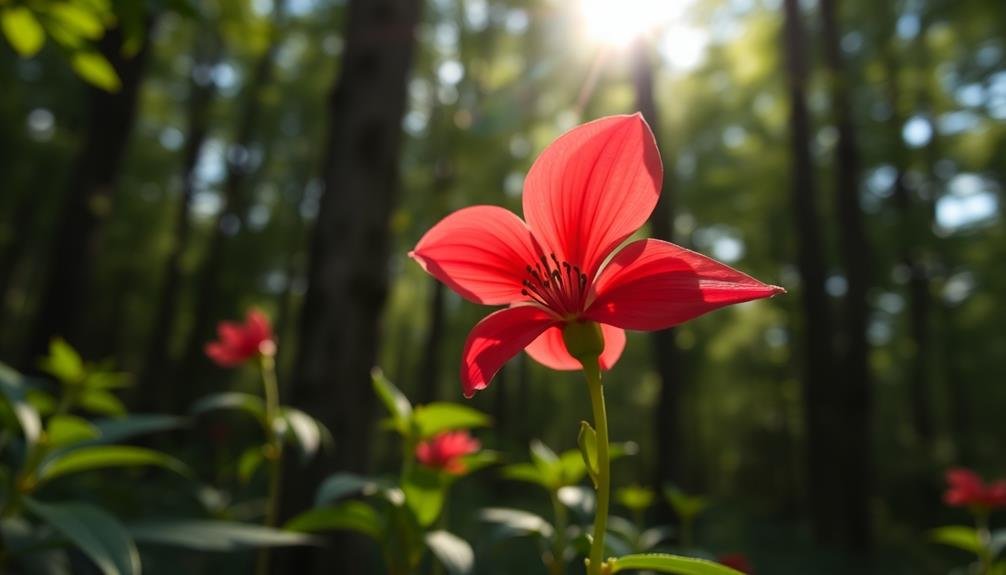
Foreground elements are key to adding depth and visual interest to your mobile photos. They create a sense of dimension and draw the viewer's eye into the scene. To incorporate effective foreground elements, look for objects close to your camera that can frame or complement your main subject.
Natural elements like branches, flowers, or rocks work well as foreground objects. Position them strategically to lead the viewer's gaze towards your focal point. You can also use man-made structures like fences, windows, or archways to achieve a similar effect.
When composing your shot, experiment with different angles and perspectives. Get low to the ground or shoot through gaps to incorporate unique foreground elements. Pay attention to the balance between foreground, middle ground, and background to create a harmonious composition.
Use selective focus to emphasize your foreground elements. By adjusting your camera's focus point or using portrait mode, you can create a shallow depth of field that blurs the background while keeping the foreground sharp. This technique adds depth and helps separate layers within your image.
Leading Lines and Diagonal Compositions
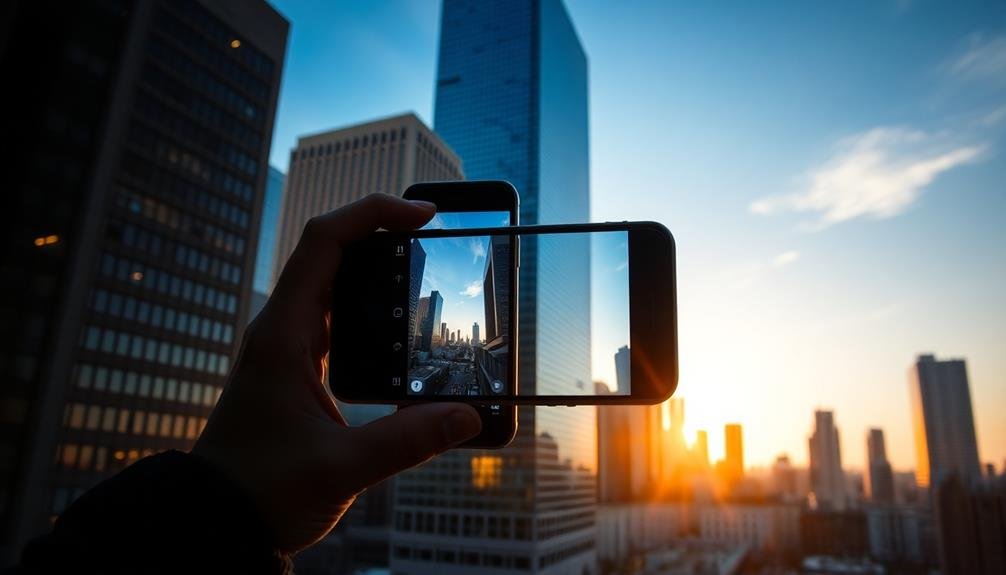
Leading lines and diagonal compositions are powerful tools for guiding the viewer's eye through your mobile photos. They create a sense of depth and movement, drawing attention to your main subject. Look for natural lines in your environment, such as roads, fences, or architectural features, and use them to direct the gaze.
When composing your shot, position these lines to lead towards your focal point. Diagonal lines are particularly effective, as they add dynamism and energy to your images. Try tilting your phone slightly to create diagonal compositions from straight lines.
Here's a quick guide to different types of leading lines and their effects:
| Line Type | Direction | Effect |
|---|---|---|
| Horizontal | Left to right | Calm, stable |
| Vertical | Top to bottom | Strong, imposing |
| Diagonal | Corner to corner | Dynamic, energetic |
Experiment with converging lines, such as train tracks or tree-lined avenues, to create a strong sense of perspective. Remember, leading lines don't always have to be straight; curves and S-shapes can add a graceful flow to your composition. Practice identifying and incorporating these elements to elevate your mobile photography and create more engaging, visually compelling images.
Frame Within a Frame Technique
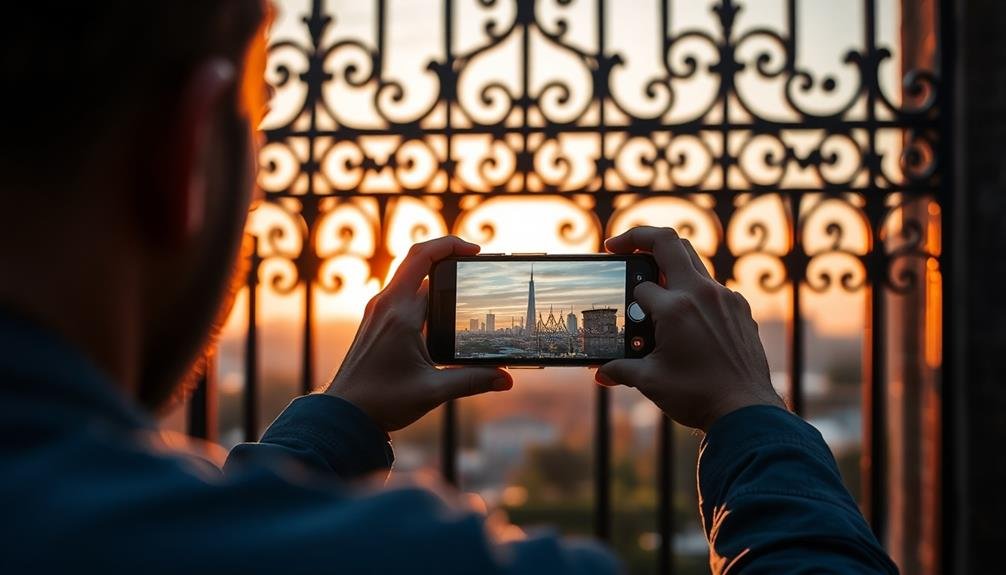
While leading lines guide the viewer's eye, another powerful composition technique takes this concept further. The frame within a frame technique creates depth and draws attention to your main subject by using elements in the foreground to surround it. You'll find natural frames everywhere: doorways, windows, arches, tree branches, or even people's arms.
To use this technique, position your main subject within the frame you've chosen. Make certain the framing element doesn't overpower your subject but complements it. You can create contrast by having a darker frame around a brighter subject or vice versa. Experiment with different frame shapes and sizes to see what works best for your composition.
This technique isn't just about aesthetics; it adds context and narrative to your image. A subject framed by a window might suggest contemplation or longing, while an archway could imply a journey or change.
When using your mobile phone, tap to focus on your main subject to make certain it remains sharp. Don't be afraid to move around to find the perfect angle that aligns your subject with the framing element.
Reflections and Shadow Play
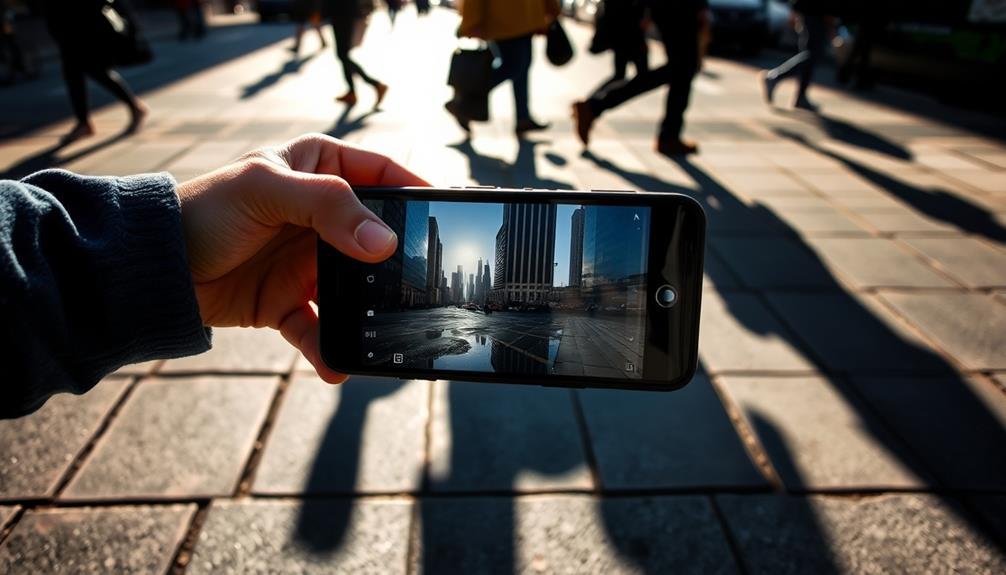
Reflections and shadows offer a unique way to add depth and intrigue to your mobile photos. They create visual layers that can transform an ordinary scene into something enchanting.
To capture reflections, look for smooth surfaces like water, glass, or polished metal. Position yourself to include both the reflected image and its source in the frame, creating a double reality effect.
For shadow play, observe how light interacts with objects throughout the day. Early morning and late afternoon provide long, dramatic shadows that can add interesting patterns to your compositions.
Use shadows to create leading lines, frame subjects, or add texture to flat surfaces. Don't shy away from harsh midday light; it can produce striking contrasts and geometric shapes.
Experiment with silhouettes by placing your subject between the light source and your camera. This technique emphasizes shape and form, adding mystery to your images.
When shooting reflections or shadows, adjust your exposure to preserve details in both light and dark areas. Remember, the interplay of light and shadow can tell a story, evoke emotions, and add a sense of depth that elevates your mobile photography.
Depth of Field in Smartphone
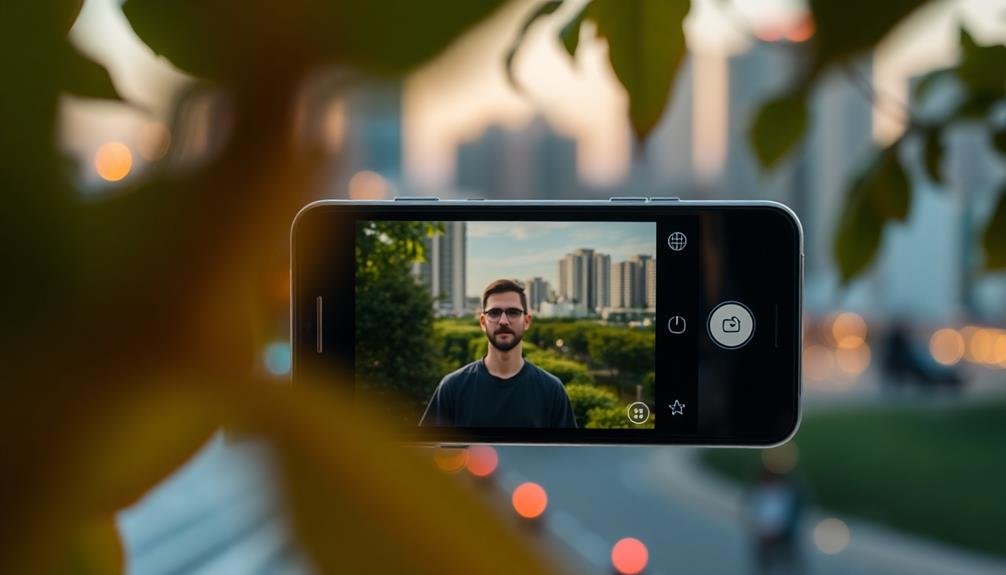
Depth of field is another powerful tool for creating layers in your smartphone photography. It refers to the range of distance in your image that appears sharp and in focus. By manipulating the depth of field, you can draw attention to specific elements and create a sense of depth in your photos.
Most smartphones now offer portrait mode, which simulates a shallow depth of field by blurring the background. Use this feature to isolate your subject and create a layered effect. Position your main subject closer to the camera and guarantee there's some distance between it and the background. This separation will enhance the blurring effect and create a more pronounced layered look.
For a deeper depth of field, tap to focus on a point about one-third into the frame. This technique, known as the "rule of thirds," helps maintain sharpness throughout most of the image. You can also experiment with manual focus options in third-party camera apps for more control over your depth of field.
Frequently Asked Questions
How Can I Create Depth in Photos Without a Professional Camera?
You can create depth in photos without a pro camera by using foreground elements, leading lines, and framing. Play with perspective, utilize natural light, and experiment with different angles. Don't forget to focus on interesting subjects in varied distances.
What Editing Apps Are Best for Enhancing Layering Effects?
You'll find great layering tools in apps like Snapseed, VSCO, and Adobe Lightroom Mobile. They offer features like selective adjustments, masks, and blending modes. Try experimenting with these to enhance depth and create stunning layered effects in your photos.
How Do Weather Conditions Affect Depth and Dimension in Mobile Photography?
Weather greatly impacts your mobile photos' depth and dimension. Fog and mist add mystery, while clear skies enhance contrast. Rain creates reflections, and golden hour lighting adds warmth. You'll capture different moods as conditions change.
Can I Achieve Layering Effects in Low-Light or Nighttime Mobile Shots?
Yes, you can achieve layering in low-light or nighttime mobile shots. Use foreground elements, play with light sources, and experiment with long exposures. Don't forget to stabilize your phone and adjust your camera settings for best results.
Are There Specific Smartphone Models That Excel at Capturing Depth?
You'll find great depth capture in newer iPhones, Google Pixels, and Samsung Galaxy models. They've got advanced camera systems with multiple lenses and sensors. Don't forget, though – your skills matter more than the device you're using.
In Summary
You've now got the tools to add depth and dimension to your mobile photos. By incorporating foreground elements, using leading lines, framing your shots creatively, playing with reflections and shadows, and mastering depth of field, you'll transform flat images into enchanting visual stories. Don't be afraid to experiment with these techniques on your next photo walk. Remember, practice makes perfect. So grab your smartphone and start layering your way to more dynamic and engaging mobile photography.





Leave a Reply